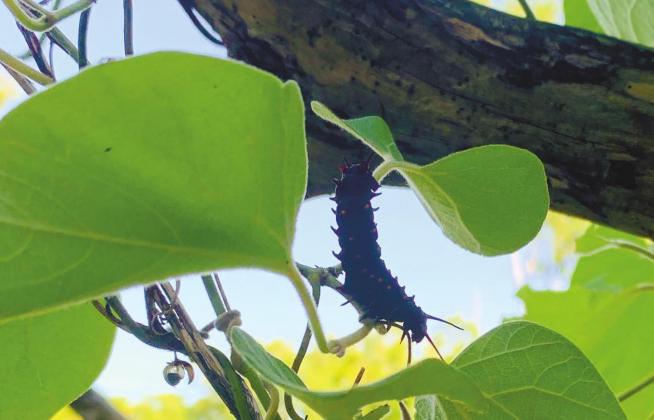Butterflies & Blooms in the Briar Patch was presented the 2021 MAG & Environmental Education Alliance of Georgia Habitat award by the co-chairs, Mary Cary and Susan Meyers, of Monarchs Across Georgia on Monday.
“The community has worked to make a haven for all creatures, and Monarchs Across Georgia commends all of you for the magnificent result!” Cary told the crowd.
Nominees for this award must be a Monarchs Across Georgia-certified Pollinator Habitat and are recognized for going above and beyond the minimum certification requirements.
Habitats are judged by a rubric. The rubric outlines the following categories: other habitat certifications, changes to the habitat overtime, enhances to the habitat for monarch observation, participation in pollinator citizen science projects, an abundance of native Milkweeds, total number of species in the habitat, sustainability practices and species identification. Another part of this rubric is educational signage, which the Butterflies & Blooms in the Briar Patch is currently working to put throughout the habitat.
“This is a big deal for our habitat,” said Virginia Linch, creator of Butterflies & Blooms in the Briar Patch. “All of this effort was made possible through myself and volunteers.”
Supporters from all over Georgia came to the presentation to share their overwhelming love and adoration for the habitat. In addition, City Manager Gary Sanders and Board of Commissioners Chairman Billy Webster came to show their appreciation.
“This project turned out to be a tremendous asset to the city,” said Sanders. “The habitat has turned into an actual treasure within Eatonton.”
Originally, the city was going to make a hiking trail or walkway out of the current residence of the habitat. However, Virginia Linch would eventually inspire a grand project that would find its home on North Jefferson Avenue and become the haven it is known as today.
Linch is an amateur wildlife photographer and the creator of Butterflies & Blooms in the Briar Patch. She became inspired to research larval host plants that led to the habitat’s creation because of a butterfly she saw while doing photography.
“I grew up on the coast and after my kids were grown, I began taking pictures today, up here,” said Linch. “I was taking pictures of the typical Southern gardens when a random butterfly was on a plant nearby. I was like, “What the heck is this about?” so I started my research and learned what larval host plants were.”
Larval host plants are native plants that butterflies will reproduce on. These host plants promise food for the next generation of butterflies and attract butterflies into an area. These plants provide sustenance and somewhere to grow that is natural to the butterfly’s senses.
“The habitat has a variety of different ecosystems. Butterflies require different plants so that’s what we’ve done,” said Linch. “And we expect to actually put in a couple more specific areas.”
Linch, with the help of several experts, created a pamphlet that can be found at the habitat to identify what butterflies go with each native larval host plant. This pamphlet became the first Georgia butterfly ID guide.
“People don’t have much respect for native plants,” said Linch. “When we remove that native element from the environment, it removes a very vital, necessary and critical link in the butterfly’s life cycle. Then, they can’t reproduce.”
While many people may refer to Butterflies & Blooms in the Briar Patch as a garden, it is considered a habitat. There is a larger distinction between a habitat and a garden. According to The National Wildlife Association, habitats are made to be planted with native species that wildlife depend on with the goal to restore the environment. Gardens, on the other hand, are created with some non-native species with the only goal of looking presentable or growing food.
“Habitats are so important because they bring back our local wildlife and bring back what’s native to our state. Here, we even have several host plants that are for endangered species,” said Linch.
The entire habitat was created by a variety of volunteers over the years who have helped to continuously put in new plants, build structures and adapt the ecosystems as the city develops each year.
“There’s always something that can be done,” said Fred Parker, volunteer. “It’s extremely rewarding to volunteer.”
Parker met Linch when she began the old butterfly habitat on Aluminum Hill. At the time, Parker was just a visitor to the garden but he was always surprised at the dedication and hard work that Linch put into it whenever he would visit.
“I think it was just seeing her out there doing everything she does that was inspiring,” said Parker. “This was a good thing for me to get involved in because I like fixing things, and I wanted to contribute to this cause.”
Another volunteer, Jim Collins, recently started visiting and working on the habitat with Parker. Similarly to Parker, Collins was a visitor who simply enjoyed walking around the habitat
“I just recently got involved in volunteering but I enjoy the habitat overall. It’s the perfect place to walk, and it really brings a nice, colorful area to our town,” said Collins.
To see the variety of species and different host plants, visit the garden, pick up an ID guide and take a guided tour around the different ecosystems. The habitat benefits the natural wildlife and offers the perfect educational walk for tourists, local citizens and groups.


